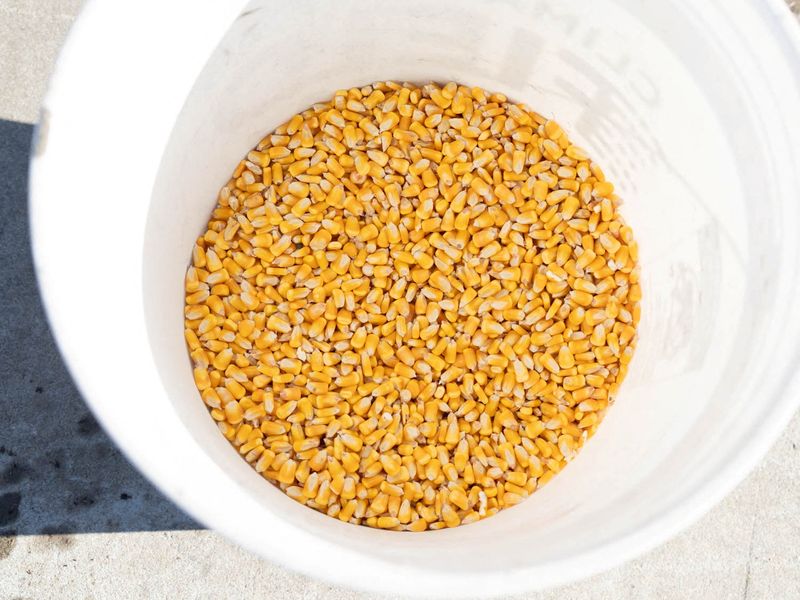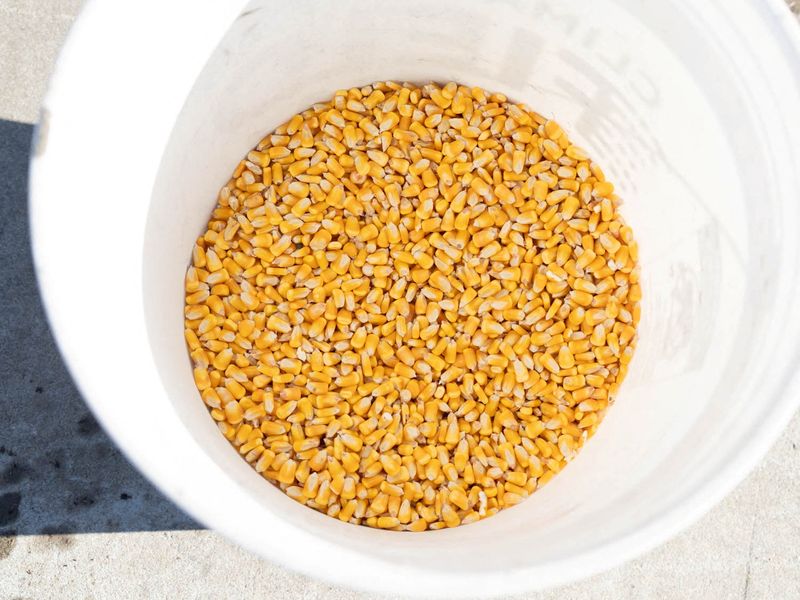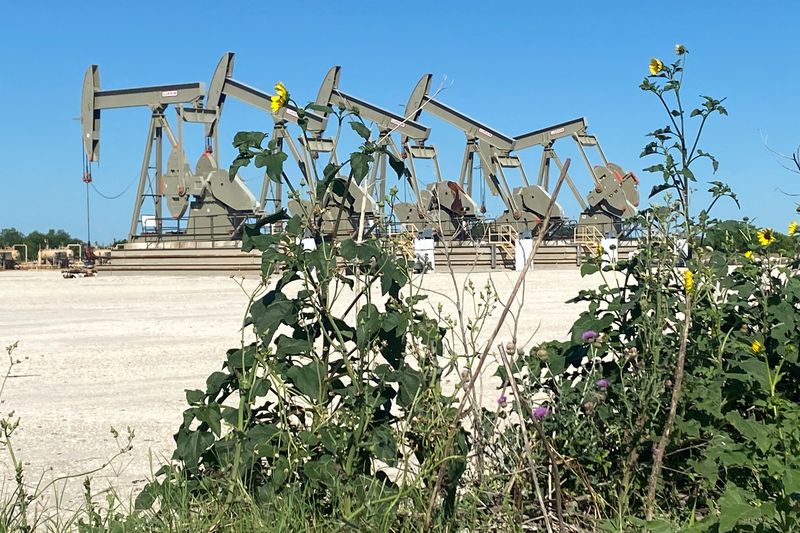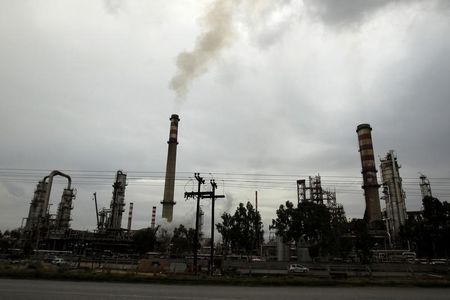Commodities
US farmers face harsh economics with record corn supplies in silos


© Reuters. Corn out of one of the bins at farmer Dan Henebry’s farm is pictured, in Buffalo, Illinois, U.S., February 18, 2024.REUTERS/Lawrence Bryant/File Photo
By Tom Polansek
CHICAGO (Reuters) – Illinois farmer Dan Henebry regrets not selling more of his corn crop last summer, when the Midwest needed rain and prices were high.
He is not alone.
Farmers across the United States are kicking themselves for putting off corn sales after fields dried up in May and June, fueling expectations for higher prices and smaller harvests. Instead, prices tanked as rains saved the crop. The size and speed of the price collapse stung farmers and left their storage bins stuffed with record amounts of corn.
The steepest market downturn in a decade in 2023 has extended into 2024, hurting the U.S. rural economy. Two years of high prices and tight crop supplies spurred by unfavorable global weather and disruption from the Ukraine war have been quickly reversed.
Record-large harvests in the United States and Brazil, increased competition for U.S. grain exports, and limited domestic demand led to hefty amounts of corn locked away in storage, pushing U.S. corn prices to their lowest level since November 2020 on Wednesday.
Corn is the world’s most traded commodity crop and often sets the tone for other crops. Soybeans, too, plummeted to their lowest prices in more than three years in February.
Ten farmers, economists and market analysts said U.S. growers miscalculated when they held on to corn rather than booking sales. The “store and ignore” strategy of waiting for higher prices has not paid off, leaving some farmers cutting back purchases of pricey equipment and planting less corn. The interviews also demonstrate the tricky decisions farmers face when determining when to sell in the face of potential crop losses.
Corn futures prices that approached $6.30 a bushel in June have since tumbled to $4.10, after U.S. farmers ultimately produced record crop yields.
“I wish I sold a lot more,” Henebry said.
U.S. growers held a whopping 7.83 billion bushels of corn in storage bins on their farms as of Dec. 1, the most ever for that date and up 16% from a nine-year low in December 2022, U.S. government data show. Globally, leftover inventories are projected to reach a five-year high by September after accounting for all the corn used to feed livestock, make biofuels and other purposes.
Henebry said he still has about 40% of his 2023 harvest in storage, including 30,000 bushels on his farm in central Illinois. He is paying 3 to 4 cents per bushel a month to keep another 30,000 bushels at a local grain elevator. In a normal year, he would not have any still stored there, he said.
Before prices plunged last summer, Henebry said he sold some corn for $5.50 to $5.70 per bushel and then for as much as $6.21 per bushel delivered to the grain elevator. He held off on further sales because he was counting on poor weather to reduce production and boost prices.
Prices tumbled, though, and Henebry said he sold corn in December for $4.60 per bushel. He wishes he would have unloaded even more at that price.
Prices will come under renewed pressure as farmers do sell the grain they have in storage, analysts said.
“Any sort of little rally, there’s going to be a lot of corn sold,” said Henebry.
‘I’LL JUST GIVE UP’
Fred Huddlestun, a farmer in Yale, Illinois, said he still had his entire 2023 corn harvest in storage last month: about 39,000 bushels at an elevator and 25,000 bushels at home. Prices never reached targets he set to make sales last year, even as he lowered them.
Huddlestun could have earned roughly $360,000 if he had struck deals to sell 64,000 bushels just after Easter; $382,000 around Father’s Day in June; and $307,000 on Halloween, based on Chicago Board of Trade corn futures that represented last autumn’s crop. At current prices, his grain is worth about $263,000. Futures and cash prices often differ by a few cents.
“I kept thinking the market would go up,” Huddlestun said. “I’ll just give up eventually and start selling if nothing happens.”
Huddlestun said he should have sold around $5.50 a bushel. Though all operations are different, breakeven prices for corn growers in central Illinois were about $5.27 a bushel in 2023, including costs for land and other expenses, according to University of Illinois estimates.
Farmers have the space to squirrel away crops after increasing their storage capacity by 24% over the last two decades to 13.6 billion bushels. Storing grain gives farmers more control over when and how they sell, to avoid prices that are typically low at harvest time and to best take advantage of spikes in futures. At grain elevators and other commercial handlers, off-farm storage capacity has increased by 40% to 11.9 billion bushels over the past 20 years, according to U.S. government data.
High interest rates make storage more costly because farmers’ crops are tied up in bins rather than sold to reduce debt, economists said.
In southern Illinois, the second biggest corn-producing state, farmers could actually lose up to $160 an acre growing corn this year, based on corn prices and the cost of production, University of Illinois economists said in a January report. Two years ago, profits reached about $340 an acre.
Such expected losses are rippling through rural America. Net farm income in 2024 is projected to suffer the largest year-to-year dollar decrease in history, the American Farm Bureau Federation, an industry group, said in a report this month.
Deere (NYSE:) & Co, the world’s largest farm equipment maker, expects sales of large agricultural equipment to decline 20% this year, due to lower commodity prices and high interest rates.
‘PLENTY OF CORN’
In Wamego, Kansas, Glenn Brunkow, a fifth-generation crop and livestock farmer, plans to delay upgrades to machinery and may try to repair equipment himself, rather than paying a dealership.
“We’re tightening expenses as much as we can,” he said. “We’re trying to limp through putting off some expansion with the livestock, just trying to limp by.”
Early forecasts show U.S. farmers are likely to cut back on corn planting and favor soybeans in 2024. They may struggle to turn a profit with either crop.
Brunkow said he plans to forgo corn planting entirely and grow some sorghum, which requires less fertilizer and has less expensive seeds than corn. Sorghum can be used to make ethanol, feed livestock or be exported to China to make baiju liquor.
Years ago, Brunkow gave up on growing sorghum because it produces lower yields and is difficult to dry at harvest time.
Now, “the economics just are better,” he said. “You’re going to lose less money.”
Analysts do not expect a major bump in demand to draw down corn stockpiles. U.S. exports of agricultural and related products fell 10% by value in 2023 to a three-year low, as plentiful supplies from Brazil and elsewhere challenged U.S. export sales.
Demand from the U.S. meat industry, which feeds corn to livestock, is limited as pig farmers face lackluster pork demand while cattle ranchers slashed their herds due to drought in the Great Plains.
Biofuel demand, which typically accounts for about one-third of U.S. corn production, also worries Rod Weinzierl, executive director of the Illinois Corn Growers Association, as Americans buy more electric vehicles.
“This year every fork in the road has been bearish,” said Matt Wiegand, commodity broker for risk management firm FuturesOne in Nebraska.
Commodities
Oil set for weekly gain on signs of improving demand

By Shariq Khan
NEW YORK (Reuters) – Oil prices rose in Asian trading hours on Friday, with global benchmark Brent set for its first weekly increase in three weeks on signs of improving global demand and slowing inflation in top oil consumer the United States.
prices rose 21 cents, or 0.3%, to $83.48 a barrel by 0018 GMT. U.S. West Texas Intermediate (WTI) crude futures rose 18 cents, or 0.2%, to $79.41 a barrel.
Brent futures are set to rise about 1% on a weekly basis, and WTI futures are set to gain 1.4%.
Recent declines in oil and refined products inventories at major global trading hubs have created optimism over oil demand growth, reversing a trend of rising stockpiles that had weighed heavily on prices in prior weeks. Through Thursday, Brent crude futures were down around 10% from this year’s peak of $92.18 a barrel on April 12.
U.S. oil and fuel inventories fell last week, while Singapore’s middle distillate fuel stocks dropped to a near three-month low this week. In Europe’s Amsterdam-Rotterdam-Antwerp trading hub, gasoline stocks were down 7.5% in the week to Thursday, data from consultancy Insights Global showed.
Recent economic indicators from the United States have fed into the optimism over global demand. U.S. consumer prices rose less than expected in April, data showed on Wednesday, boosting expectations of lower interest rates in the country.
Those expectations were further bolstered by data on Thursday that showed a stabilizing U.S. job market.
remove ads
.
Lower interest rates could help soften the U.S. dollar, which would make oil cheaper for investors holding other currencies and drive demand.
“Financial markets now have placed the most bets on a September interest rate cut by the Federal Reserve, which would continue to temper the dollar strength and shift that strength over to commodities and equities,” StoneX oil analyst Alex Hodes said on Thursday.
Commodities
Goldman Sachs discusses what’s next for natural gas prices

Over the past three weeks, US prices have surged 30% to above $2.50 per million British thermal units (mm/BTU), fueled by production declines and increased feedgas demand for liquified natural gas (LNG) exports.
Moreover, recent producer cuts, maintenance events, and Freeport LNG’s normalization of gas demand post-outage have contributed to this rise. Cheniere’s announcement of no heavy maintenance for its liquefaction trains this year also supports higher prices.
In a Thursday note, Goldman Sachs strategists said the return of gas prices above $2/mmBtu aligns with their expectations, as production curtailments “would ultimately lead to lower storage congestion risks for this summer.”
“That said, we see only limited further upside from current levels, with stronger gas prices risking a return of congestion concerns,” they added.
Goldman notes that prices above $2/mmBtu reduce gas competitiveness compared to coal, with a $0.50/mmBtu increase potentially cutting gas demand by 1 billion cubic feet per day (Bcf/d), especially in shoulder months.
Moreover, higher prices may prompt the restart of previously shut-in wells. EQT (ST:), the largest producer in the Appalachia region, indicated it would resume production if prices sustainably exceed $1.50/mmBtu. And while Appalachia prices haven’t risen as much as NYMEX, the local hub has averaged $1.44/mmBtu month-to-date, up 10¢ from last month, strategists highlighted.
Elsewhere, European gas prices have also risen this summer, though less sharply than in the US.
Title Transfer Facility (TTF) prices increased 18% over the past three months to around 30 euros per megawatt-hour (MWh), holding steady in May.
remove ads
.
However, unlike the US market, this rally lacks fundamental support, with Northwest (NW) European gas storage at record-high levels, Goldman strategists pointed out.
“To be sure, NW European LNG imports have remained weak relative to last year – and are likely to get weaker in the coming weeks owing to a seasonal decline in global LNG production, exacerbated by outages at Australia’s Gorgon export project,” they said.
“Going forward, we expect healthy non-European demand for LNG to continue to incentivize a decline in European LNG imports vs last year,” they continued.
Commodities
Gold prices trim some weekly gains on tempered rate cut hopes

Investing.com– Gold prices fell slightly on Friday, trimming some of their gains for the week as comments from a slew of Federal Reserve officials offered a more sobering outlook on interest rate cuts.
The yellow metal had risen to nearly $2,400 an ounce this week in the immediate aftermath of some soft U.S. economic readings. But it pulled back from these levels on Thursday and Friday.
steadied at $2,377.40 an ounce, while expiring in June fell slightly to $2,381.10 an ounce by 00:19 ET (04:19 GMT).
Gold retreats as Fed officials downplay rate cuts, but weekly gains due
The yellow metal fell on Thursday after a string of Fed officials cautioned against bets on immediate reductions in interest rates.
Several members of the central bank’s rate setting committee said the central bank will need much more convincing that inflation was coming down beyond a marginally soft inflation reading for April.
This saw traders begin pricing out some expectations for a rate cut in September. The and also rebounded from earlier losses this week.
Still, some softer-than-expected readings put gold on course for a 0.7% weekly gain.
The yellow metal was also in sight of a record high of above $2,430 an ounce, although it appeared unlikely the level would be met in the near-term.
Other precious metals retreated on Friday, but were set for bumper weekly gains. fell 0.2% but were trading up 6.2% for the week, while fell 0.4% but were up 4.5% this week.
remove ads
.
Copper mixed amid middling China cues
Among industrial metals, one-month copper futures tumbled from two-year highs tracking middling economic data. But three-month copper futures pushed higher and were set for a stellar week as markets bet on tighter supplies and an eventual demand recovery in the coming months.
on the London Metal Exchange rose 0.6% to $10,445.0 a ton, while rose 0.3% to $4.8935 a pound.
Data from China on Friday painted a mixed picture of the economy. While grew more than expected, growth slowed and shrank at an accelerated pace. Growth in Chinese also slowed.
The readings presented a muddled outlook for the world’s biggest copper importer, as it rolled out more stimulus measures to shore up growth.
Three-month copper futures gained on the prospect of a demand recovery, and were up nearly 4% this week. They were also at two-year highs.

 Forex2 years ago
Forex2 years agoForex Today: the dollar is gaining strength amid gloomy sentiment at the start of the Fed’s week

 Forex2 years ago
Forex2 years agoHow is the Australian dollar doing today?

 Forex1 year ago
Forex1 year agoUnbiased review of Pocket Option broker

 Forex2 years ago
Forex2 years agoDollar to pound sterling exchange rate today: Pound plummeted to its lowest since 1985

 Cryptocurrency2 years ago
Cryptocurrency2 years agoWhat happened in the crypto market – current events today

 World2 years ago
World2 years agoWhy are modern video games an art form?

 Stock Markets2 years ago
Stock Markets2 years agoMorgan Stanley: bear market rally to continue

 Economy2 years ago
Economy2 years agoCrude oil tankers double in price due to EU anti-Russian sanctions

































